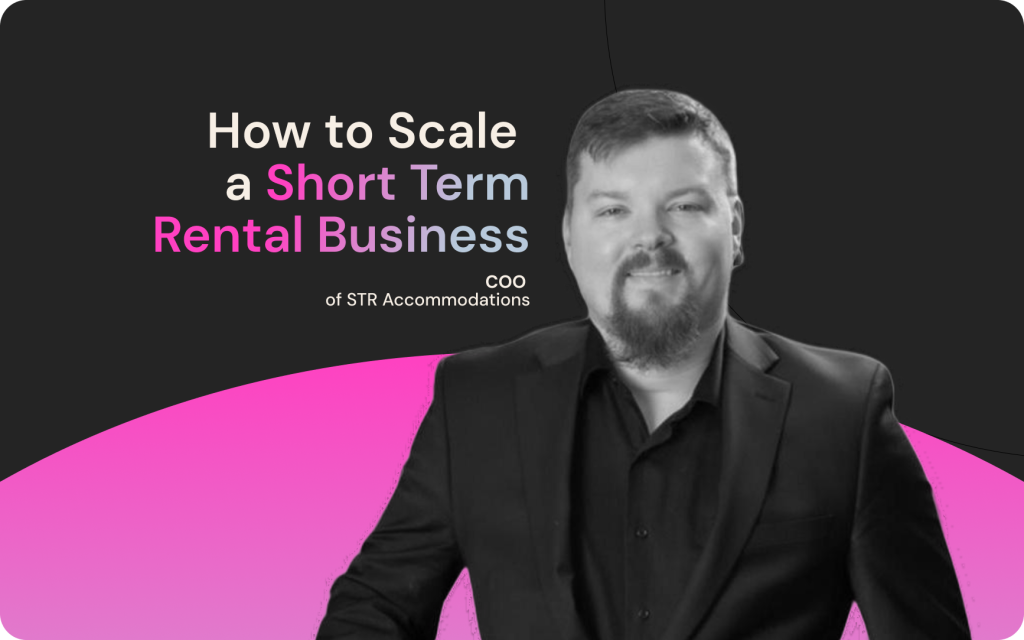Learning how to scale a short term rental business is a complex task that requires a blend of expertise and strategic foresight. Cody Wood, COO of STR Recommendations in Texas, built a thriving STR business that spans the US.
Watch our interview with Cody Wood and read his success story.
Smart scaling
Cody’s journey began with a simple “house hacking” strategy of renting out a spare guest bedroom in his own house and swiftly adding a second guest room.
Next, he found a business partner in STR accommodations and the company exploded. His partner brought in 75 properties which he managed with very little technology, operations, or systems. Within 8 months the company had grown to over 157 properties.
“It was the definition of chaos or a hectic host,” said Cody.
The partners quickly realised some things were going well and some weren’t.
“We dialled it back to around 60 properties and soon we were making the same amount of money we made with 157,” said Cody. This experience taught them the importance of scaling with intention.
“Quantity doesn’t always equal profitability when it comes to working out how to scale a short term rental business,” said Cody.
This insight is a cornerstone in understanding how to scale Airbnb and STR businesses effectively.
The STR management blueprint
When tackling the question of “how do you scale Airbnb?” Cody applied an engineer’s precision to STR management. The company broadened its services from property management to include offering tech support and property analysis, as well as ‘light’ coaching which has become core pillars of their scalable model.

Growing your short term rental business sustainably
For Cody, choosing the right properties and partners is key to sustainable STR growth. “It’s finding the right properties to work with, the right homeowners, the right investors,” he states, highlighting a critical strategy for anyone looking to scale short term rental operations.
Keeping abreast of market changes
Cody emphasizes the importance of market dynamics in scaling STR businesses, “Research how many properties are in the area, and their occupancy levels. Do your homework, and understand that that’s what’s going to get you the most bang for your buck today.”
Maintaining the personal touch in vacation rentals
Scaling doesn’t mean losing the personal touch. Cody prides himself on balancing growth with customer satisfaction, “I enjoy talking to the guests… most of the time I can diffuse them quickly just by asking questions.”
“By using Superhog’s damage waiver process, Superhog handles the back end for us – and we can focus on being a hospitality company. We want guests to have a great time and if we have to chase them for money, we’re no longer hospitable.”
Using technology to offer the same service as the OTAs
Cody realised that using Superhog’s safety and security features enabled him to offer similar services as the OTAs – which enabled them to build enough confidence with clients to transition them from the OTA platforms to directly booking with STR Accommodations. This strategy enabled them to expand the direct booking side of the business.

Planning for damages
“We always have damages with our short term rental properties. It’s just the nature of the business. It’s going to happen. One of the things we were looking for early on was to make sure that the cost of damages wasn’t coming out of our pocket, or the homeowners’ pockets. And we wanted to encourage guests to take care of the properties.”
Through the damage waiver process – guests are encouraged to look after properties, and when things go wrong, Superhog deals with the fall-out, said Cody.
The final word on scaling
To wrap up, Cody offers this piece of advice, “Make sure you take the time to map your business. Draw out your client’s journey, map your guest’s journey, and your systems. Take your time to draw a line chart and work out steps one, two, and three. You’ll probably miss things, but at least you have something you can evolve with your team. And your team will respond better because you can show them an overarching process or the big picture of what you’re trying to achieve.
Whereas if you’re running around on the cell phone all the time trying to do everything yourself, you’re setting yourself up for just constant chaos. You can scale chaos to some degree, but at some point, it’s all going to come crumbling down. And so it’s much better to take your time.
In conclusion, scaling a short-term rental business is both an art and a science. Cody’s approach provides a blueprint for success, proving that strategic growth, coupled with a strong grasp of hospitality, can propel your STR business to new heights.

